
Imagine submerging yourself into the open turquoise sea, and as you finally complete equalising the air pressure in your ears, you look around to take in
this view.....
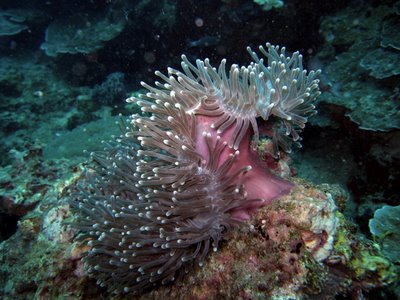
... this is why I love scuba diving so much. The infinite beauty of Neptune's world takes my breath away every time I see the flowing arms of the sea anemone dance and sway to the beat of the underwater current.

Once in a while, you get to see creatures that are quite literally, out of this world. Take this pufferfish for example. We all know that the pufferfish is one ugly dude (I'm reminded of my secondary school chem teacher, but shhhh.....); but this is not your garden variety puffer, nosiree. This is one puffer with attitude and knows it. It's called the Papuan toby or
Canthigaster papua. If you ask me, I'd call it the Angelinajolie toby (Canthigaster stealrachelshusbandii).

I almost missed this one. I was so busy focusing the camera on the shrimps (lower left) that I completely didn't see it. Thanks to Yanni (again) for alerting me to this beauty in front of me, a juvenile Longnose Hawkfish. Isn't it cute?
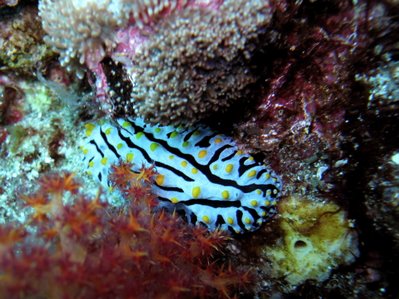
The nudi-enthusiast in me couldn't resist taking a shot of this common nudi, a Phyllidia varicosa, even though the rest of the team were already 10 meters away. It's times like this that I miss Chris, my partner-in-crime when it comes to nudi-hunting.

I am not too sure about this fella, is it a reef oyster or the more exotic pearl oyster? If it's the latter, then, dang! I should've opened it up to check for treasure.
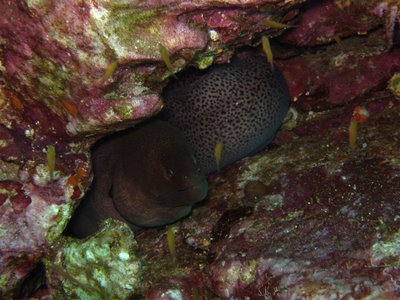
Someone commented that moray eels have very smiley faces. This fella seems like he's in a good mood, eh? Say cheese!

The juvenile emperor angelfish is one of the most difficult subjects to shoot (along with my other nemesises, the juvenile sweetlips and the yellow boxfish). It flits around and ducks into dark corners and swims around rocks and pops in and out of the corals and....

...and when it grows up, it will look like this fish, Emperor Angelfish Sr. I prefer the mature version more because it is of course a lot bigger and more regal looking. But more importantly, it doesn't run around like a headless chicken!
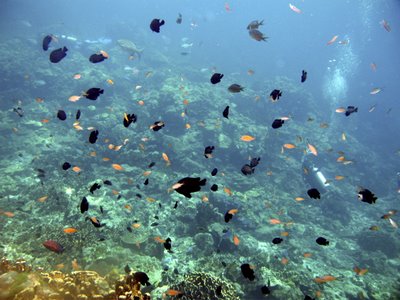
At the end of each dive, we would have to make a safety stop at a depth of 15ft or 5m for about 3 minutes to get rid of the excess N2 gas still trapped in our circulation. It is also a very good opportunity to snap panoramic pics of the coral beds and the fishes that live in them as there is lots of sunlight at this shallow depth which affords me very colourful and lively shots.
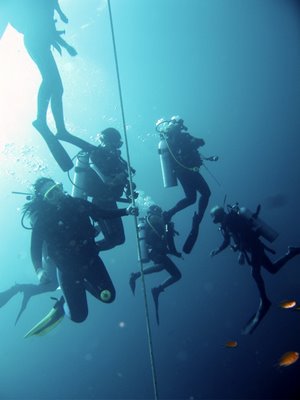
All too soon, another dive is over. And one by one we surface using the rope line as a guide so we don't go up too rapidly lest my ultra-conservative dive comp start beeping its head off again.
 Imagine submerging yourself into the open turquoise sea, and as you finally complete equalising the air pressure in your ears, you look around to take in this view.....
Imagine submerging yourself into the open turquoise sea, and as you finally complete equalising the air pressure in your ears, you look around to take in this view..... ... this is why I love scuba diving so much. The infinite beauty of Neptune's world takes my breath away every time I see the flowing arms of the sea anemone dance and sway to the beat of the underwater current.
... this is why I love scuba diving so much. The infinite beauty of Neptune's world takes my breath away every time I see the flowing arms of the sea anemone dance and sway to the beat of the underwater current. Once in a while, you get to see creatures that are quite literally, out of this world. Take this pufferfish for example. We all know that the pufferfish is one ugly dude (I'm reminded of my secondary school chem teacher, but shhhh.....); but this is not your garden variety puffer, nosiree. This is one puffer with attitude and knows it. It's called the Papuan toby or Canthigaster papua. If you ask me, I'd call it the Angelinajolie toby (Canthigaster stealrachelshusbandii).
Once in a while, you get to see creatures that are quite literally, out of this world. Take this pufferfish for example. We all know that the pufferfish is one ugly dude (I'm reminded of my secondary school chem teacher, but shhhh.....); but this is not your garden variety puffer, nosiree. This is one puffer with attitude and knows it. It's called the Papuan toby or Canthigaster papua. If you ask me, I'd call it the Angelinajolie toby (Canthigaster stealrachelshusbandii). I almost missed this one. I was so busy focusing the camera on the shrimps (lower left) that I completely didn't see it. Thanks to Yanni (again) for alerting me to this beauty in front of me, a juvenile Longnose Hawkfish. Isn't it cute?
I almost missed this one. I was so busy focusing the camera on the shrimps (lower left) that I completely didn't see it. Thanks to Yanni (again) for alerting me to this beauty in front of me, a juvenile Longnose Hawkfish. Isn't it cute? The nudi-enthusiast in me couldn't resist taking a shot of this common nudi, a Phyllidia varicosa, even though the rest of the team were already 10 meters away. It's times like this that I miss Chris, my partner-in-crime when it comes to nudi-hunting.
The nudi-enthusiast in me couldn't resist taking a shot of this common nudi, a Phyllidia varicosa, even though the rest of the team were already 10 meters away. It's times like this that I miss Chris, my partner-in-crime when it comes to nudi-hunting. I am not too sure about this fella, is it a reef oyster or the more exotic pearl oyster? If it's the latter, then, dang! I should've opened it up to check for treasure.
I am not too sure about this fella, is it a reef oyster or the more exotic pearl oyster? If it's the latter, then, dang! I should've opened it up to check for treasure. Someone commented that moray eels have very smiley faces. This fella seems like he's in a good mood, eh? Say cheese!
Someone commented that moray eels have very smiley faces. This fella seems like he's in a good mood, eh? Say cheese! The juvenile emperor angelfish is one of the most difficult subjects to shoot (along with my other nemesises, the juvenile sweetlips and the yellow boxfish). It flits around and ducks into dark corners and swims around rocks and pops in and out of the corals and....
The juvenile emperor angelfish is one of the most difficult subjects to shoot (along with my other nemesises, the juvenile sweetlips and the yellow boxfish). It flits around and ducks into dark corners and swims around rocks and pops in and out of the corals and.... ...and when it grows up, it will look like this fish, Emperor Angelfish Sr. I prefer the mature version more because it is of course a lot bigger and more regal looking. But more importantly, it doesn't run around like a headless chicken!
...and when it grows up, it will look like this fish, Emperor Angelfish Sr. I prefer the mature version more because it is of course a lot bigger and more regal looking. But more importantly, it doesn't run around like a headless chicken! At the end of each dive, we would have to make a safety stop at a depth of 15ft or 5m for about 3 minutes to get rid of the excess N2 gas still trapped in our circulation. It is also a very good opportunity to snap panoramic pics of the coral beds and the fishes that live in them as there is lots of sunlight at this shallow depth which affords me very colourful and lively shots.
At the end of each dive, we would have to make a safety stop at a depth of 15ft or 5m for about 3 minutes to get rid of the excess N2 gas still trapped in our circulation. It is also a very good opportunity to snap panoramic pics of the coral beds and the fishes that live in them as there is lots of sunlight at this shallow depth which affords me very colourful and lively shots. All too soon, another dive is over. And one by one we surface using the rope line as a guide so we don't go up too rapidly lest my ultra-conservative dive comp start beeping its head off again.
All too soon, another dive is over. And one by one we surface using the rope line as a guide so we don't go up too rapidly lest my ultra-conservative dive comp start beeping its head off again.

2 comments:
great pics :D..... the strobe is a good investment .... more pics please
Excellent pics. Thanx for sharing. Yeah... I saw a few hawkfish but they were too active for my patience. Hahaha... didn't want to be left behind by others, lar, just because need to "camp" at one spot to get ONE good pic of a hawkfish. Duh!
Post a Comment